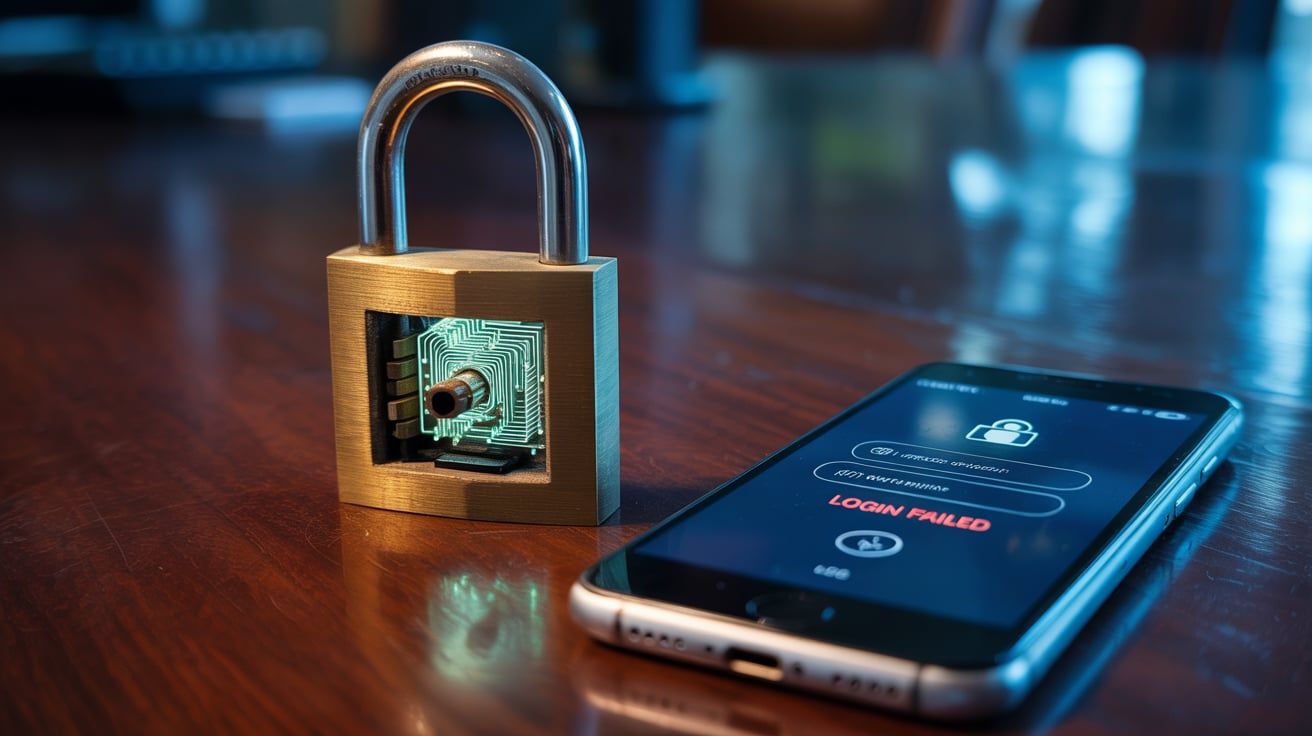How Hackers Actually Steal Your Passwords (And the Fix Takes 5 Minutes)
The Password Paradox: Security vs. Convenience
Imagine this: you're locked out of your bank account. Panic sets in. You try every password you can think of, but nothing works. This isn't just a minor inconvenience; it's a stark reminder of how much of our lives are secured (or insecurely) behind a simple string of characters. We all know we *should* have strong, unique passwords for every account, but let's be honest, who actually does? The reality is, the more complex and secure we make our passwords, the harder they are to remember, leading many of us down the path of password reuse and easily guessable combinations. This creates a perfect storm for hackers, turning our digital lives into vulnerable targets.
The truth is, password security isn't just about choosing a complex string of characters. It's about understanding the various ways hackers can bypass even the most intricate passwords and implementing the right defenses. It's a constant arms race, and staying informed is your best weapon. In this article, we'll delve into the most common methods hackers use to steal your passwords, and more importantly, we'll show you how to protect yourself with simple, actionable steps that take just minutes to implement.
Phishing: The Art of Deception
Phishing attacks are one of the oldest and still most effective methods hackers use to steal passwords. It's a form of social engineering where attackers impersonate legitimate entities, like your bank, a popular social media platform, or even your favorite online store, to trick you into revealing your login credentials. These attacks often come in the form of emails, text messages, or even phone calls, designed to look and feel authentic.
The key to a successful phishing attack is creating a sense of urgency or fear. For example, an email might claim your account has been compromised and you need to reset your password immediately by clicking a provided link. This link, however, leads to a fake website that looks identical to the real one. Once you enter your username and password, the hackers have your credentials. Always scrutinize emails and messages, especially those asking for personal information. Look for typos, grammatical errors, and inconsistencies in the sender's address. Hover over links before clicking to see the actual URL they lead to. If anything seems suspicious, contact the organization directly through their official website or phone number.
Brute-Force Attacks: Cracking the Code
Brute-force attacks are exactly what they sound like: a relentless attempt to guess your password by trying every possible combination of characters. While this method might seem primitive, it can be surprisingly effective, especially against weak or common passwords. Hackers use specialized software and powerful computers to automate the process, trying millions or even billions of password combinations per second.
The best defense against brute-force attacks is a strong, unique password. The longer and more complex your password, the more difficult it is to crack. Aim for a minimum of 12 characters and include a mix of uppercase and lowercase letters, numbers, and symbols. Avoid using easily guessable information like your name, birthday, or pet's name. Also, never reuse the same password across multiple accounts. If one account is compromised, all accounts using the same password are at risk. Consider using a password manager to generate and store strong, unique passwords for all your online accounts. These tools not only create secure passwords but also automatically fill them in when you visit a website, making your online experience more secure and convenient.
Keylogging: Silently Recording Your Every Keystroke
Keylogging is a more sophisticated method where hackers install malicious software, either physically or remotely, on your computer or mobile device to record every keystroke you make. This means that anything you type, including your usernames, passwords, credit card numbers, and personal messages, is captured and sent to the attacker. Keyloggers can be difficult to detect, as they often run silently in the background without any visible signs of infection.
Protecting yourself from keyloggers requires a multi-layered approach. First, install and maintain a reputable antivirus software program and keep it updated. This software can detect and remove known keyloggers. Second, be cautious about clicking on suspicious links or downloading files from untrusted sources. These are common ways keyloggers are distributed. Third, consider using a virtual keyboard when entering sensitive information, especially on public computers. A virtual keyboard displays the keys on the screen, making it more difficult for a keylogger to capture your keystrokes. Finally, regularly scan your computer for malware and spyware to ensure your system is clean.
Password Reuse: The Domino Effect of Compromise
Password reuse is arguably the single biggest mistake people make when it comes to password security. Using the same password across multiple accounts creates a domino effect: if one account is compromised, all accounts using that password are at risk. This is because hackers often use automated tools to test stolen credentials on other popular websites and services.
Imagine a hacker gains access to your email account. If you use the same password for your bank account, social media accounts, and online shopping accounts, they now have access to all of them. This can lead to financial loss, identity theft, and reputational damage. The solution is simple: use a unique password for every account. This may seem daunting, but password managers can make it easy to generate and store strong, unique passwords for all your online accounts. They also automatically fill in your login credentials when you visit a website, saving you time and effort.
Man-in-the-Middle Attacks: Eavesdropping on Your Data
Man-in-the-middle (MITM) attacks involve hackers intercepting the communication between you and a website or service. They position themselves between you and the server, allowing them to eavesdrop on your data, including your usernames, passwords, and other sensitive information. This type of attack is often carried out on unsecured Wi-Fi networks, such as those found in coffee shops or airports.
To protect yourself from MITM attacks, avoid using public Wi-Fi networks for sensitive transactions, such as online banking or shopping. If you must use public Wi-Fi, use a virtual private network (VPN). A VPN encrypts your internet traffic, making it unreadable to hackers. Look for websites that use HTTPS, which indicates that the connection is encrypted. You can verify this by looking for a padlock icon in the address bar of your browser. Be wary of websites that don't use HTTPS, especially when entering sensitive information. Also, be cautious about accepting security certificates that appear unexpectedly, as this could be a sign of a MITM attack.
Data Breaches: When Companies Fail to Protect Your Information
Data breaches occur when companies or organizations that store your personal information are hacked, and your data is exposed. These breaches can expose millions of usernames, passwords, email addresses, and other sensitive data. While you can't directly prevent data breaches from happening, you can take steps to minimize the impact if your information is compromised.
First, use a password manager to generate and store strong, unique passwords for all your online accounts. This will prevent hackers from using stolen credentials to access your other accounts. Second, monitor your credit reports and bank statements regularly for any signs of fraud or identity theft. Third, sign up for breach monitoring services that will notify you if your email address or other personal information has been compromised in a data breach. If you receive a notification, change your password immediately on any affected accounts. Finally, be cautious about sharing your personal information with companies or organizations that you don't trust.
The 5-Minute Fix: Implementing Two-Factor Authentication
While all the previously mentioned security measures are important, there's one simple step you can take right now that will significantly improve your password security: enable two-factor authentication (2FA). Two-factor authentication adds an extra layer of security to your accounts by requiring a second form of verification in addition to your password. This second factor can be something you have, like a code sent to your phone, or something you are, like a fingerprint or facial recognition.
Even if a hacker manages to steal your password, they won't be able to access your account without the second factor. Most major websites and services, including Google, Facebook, Amazon, and your bank, offer two-factor authentication. Enabling it is usually a simple process that takes just a few minutes. Go to the security settings of your account and look for the option to enable two-factor authentication. Follow the instructions to set up your preferred method of verification. By implementing two-factor authentication, you're adding a significant barrier to entry for hackers, making it much more difficult for them to access your accounts.
Take Control of Your Cybersecurity Today
Password security is an ongoing process, not a one-time fix. By understanding the methods hackers use to steal your passwords and implementing the right defenses, you can significantly reduce your risk of becoming a victim. Remember to use strong, unique passwords, enable two-factor authentication, be cautious of phishing attacks, and keep your software and apps updated. The world of cybersecurity is constantly evolving, and staying informed is crucial to protecting your digital life. Don't wait until you're a victim of a password breach to take action. Start implementing these security measures today and take control of your online security.
The first step is often the hardest, so let's make it easy. Right now, take five minutes to enable two-factor authentication on your most important account – your email. This single action will dramatically increase your security. Then, commit to using a password manager to generate and store strong, unique passwords for all your other accounts. By taking these simple steps, you'll be well on your way to a more secure and protected digital life. Don't be a statistic; be proactive and protect your passwords today. The technology is available, the knowledge is here, and the power to protect yourself is in your hands.



